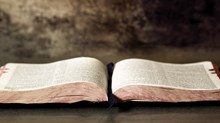Days of Celebration
Days of Celebration
Throughout his life, Jesus faithfully celebrated all of the Old Testament Jewish festivals (see Lev. 23). Like our Christian holidays, these feasts recalled God's saving acts and providence. Match the description to the correct Jewish festival below. (Note: Not all of the names listed are actual Jewish festivals.)
1. A day of thanksgiving, this feast signaled that harvest time had come to an end.
A. Pentecost
B. Yom Kippur
C. Feast of Trumpets
2. Described in the Book of Esther, this feast developed during the Babylonian captivity to commemorate the Jews' deliverance from destruction.
A. Passover
B. Purim
C. Day of Atonement
3. Worshippers thanked God for the grain he provided from the earth, and recalled his provision of manna in the wilderness.
A. Firstfruits
B. Unleavened Bread
C. Hanukkah
4. Known today as Yom Kippur, this was a solemn day of fasting before the High Priest interceded for the people's sins.
A. Day of Atonement
B. Feast of the Ark
C. Passover
5. The Israelites lived outdoors in booths during this feast to remember the 40 years of wandering in the wilderness.
A. Pillar of Fire
B. Feast of Deliverance
C. Tabernacles
6. The only Jewish feast not instituted in the OT, it celebrated the rededication of the Temple during the time of the Maccabees.
A. Day of Triumph
B. Hanukkah
C. Pentecost
Answers to Build Your Bible Power
1. C. Feast of Trumpets. Ever since God provided a ram for Abraham to sacrifice instead of his son Isaac, the sounding of a ram's horn meant deliverance. The trumpet blast at this feast signaled the harvest was over and work could cease. According to 1 Thessalonians 4:16, a trumpet will announce the end of the harvest on earth.
2. B. Purim. Haman, the enemy of the Jews, cast lots or purim to choose the day for his planned annihilation of the Jews (Esther 3:7). Through Queen Esther, God brought about the deliverance of the Jewish nation, just as Jesus delivered all those marked for destruction by our enemy, Satan.
3. B. Unleavened Bread. For seven days, the Israelites ate bread without leaven, a symbol of sin. Jesus, the sinless "bread of life" (John 6:35), was buried on the Feast of Unleavened Bread so he might bring life from the earth.
4. A. Day of Atonement. On this holiest day of the year, worshippers examined their lives for sin, which was transferred to a scapegoat led outside the city. Jesus was led outside Jerusalem to Calvary bearing our sin. The High Priest entered the Holiest Place once a year with the atoning blood. Jesus "entered the Most Holy Place once for all by his own blood ? " (Heb. 9:12).
5. C. Tabernacles. During this feast, the priests prayed for rain and poured out offerings of water to remember God's provision of this life-giving resource in the wilderness. Jesus chose this feast to announce he was the "living water" sent by God (John 7:37-38).
6. B. Hanukkah. In 165 B.C. the Greeks desecrated the Jewish temple, making it a temple to Zeus. Three years later the Jewish freedom-fighters (the Maccabees) reclaimed it. Hanukkah celebrates its rededication and the miracle that occurred: a one-day supply of lamp oil burned for eight days. On this day, also known as The Feast of Dedication, the Jewish leaders asked Jesus for a miracle to prove he was the Messiah (John 10:22-26).
Copyright © 1997 by the author or Christianity Today/Today's Christian magazine (formerly Christian Reader).
Click here for reprint information.
Read more articles that highlight writing by Christian women at ChristianityToday.com/Women
 Read These Next
Read These Next
 Flying on Faith, Hope, and HistoryLinda Finch did more than re-enact Amelia Earhart's final flight; she was sowing dreams
Flying on Faith, Hope, and HistoryLinda Finch did more than re-enact Amelia Earhart's final flight; she was sowing dreams The Gritty Reality of the NativityAre we participants or watchers of the Christmas story?
The Gritty Reality of the NativityAre we participants or watchers of the Christmas story?
 Sorting out the BibleHow Jesus changes the way I read Scripture
Sorting out the BibleHow Jesus changes the way I read Scripture








 Homepage
Homepage